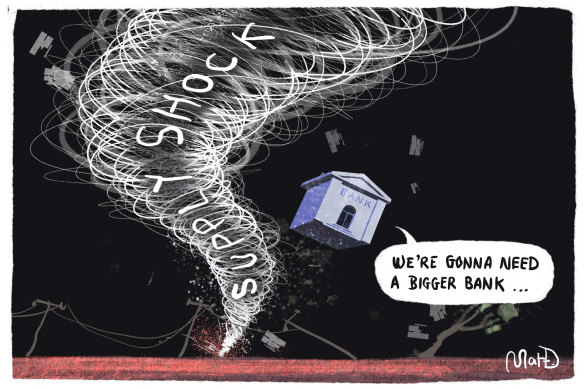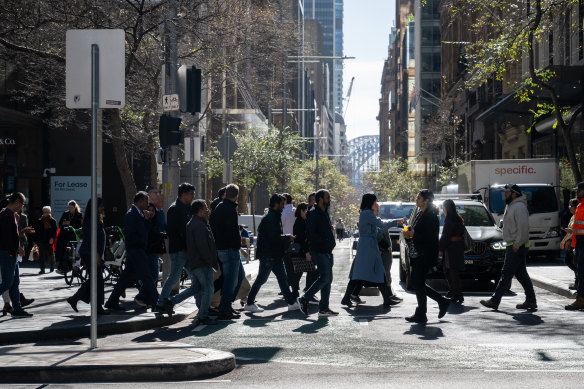This was published 6 months ago
Opinion
The big boss of central banks thinks our bankers are missing something
Millie Muroi
Economics WriterThe bank for central banks – yes, you read that right – thinks central banks around the world need to start taking things seriously. By “things”, I mean the effect of supply shocks: a flood wiping out crops, an accident taking out an oil refinery, or congestion at a port.
So far, central banks have tended to “look through”, or play down, these problems, according to the Bank for International Settlements (BIS). Why? Because even though a flood, an accident, or congestion might shrink how much the country can supply, these problems have tended to be temporary.

Credit: Matt Davidson
As you know, the amount of goods and services a country can supply is half the equation when it comes to inflation. Too little supply – compared to demand – pushes prices higher. That’s why, when demand is running higher than supply, central banks tend to jack up interest rates. Higher interest rates discourage spending (demand) and therefore help to tame inflation.
Central banks are pretty good at clamping down when inflation is driven by demand (for example, when there’s a tax cut or something to spur a flurry of spending) according to the BIS.
But BIS reckons central banks have been shrugging off supply shocks. That approach made sense in the past since these supply shocks and their impacts have tended to rewind relatively quickly. By the time a change in interest rates had had its full effect (usually with a 12 to 18 month delay), the supply hiccup would often be resolved, making it a futile – or even damaging – exercise to raise interest rates.
In fact, looking at seven advanced economies’ central banks, each with their own inflation-targeting responsibilities, monetary policy responses to demand-driven inflation have been on average more than three times bigger than responses to supply-driven inflation.
Keeping interest rates too high for too long can plunge the economy into recession and kick our extraordinary job market gains to the curb.
This is also partly because the cost of raising interest rates is higher for supply shocks than for demand shocks. That’s because when there’s a sudden surge in demand, both economic growth and prices tend to rise, whereas with a supply shock, we’re unable to produce as much (slowing down economic growth) while prices are rising. Slowing the economy further by wrenching up interest rates in the latter scenario is a lot tougher on our economy.
But BIS deputy general manager Andrea Maechler, in a speech to London School of Economics last week, said central banks couldn’t continue to look through supply shocks. That’s because the future looks different. We can expect more supply shocks, she said, especially because of climate change and heightened geopolitical tensions which make it harder to brush off a flood or supply shortages linked to war as rare, one-off events.
Some supply shocks could even wreak longer-term or permanent damage on how much we’re capable of producing. Energy prices, for example, have stayed well above pre-pandemic levels in a handful of countries.
At the same time, we’re facing longer-term supply speed bumps such as a fall in the working age population as more of us age and have fewer kids, and slowing globalisation. This means we have fewer workers, and we’re less able to just rely on trade and migration to make up for when we have a shortage of something, whether that be workers, particular materials or machines – making us a lot less agile than we once were.
If there’s one thing we’ve learned from the post-pandemic inflation surge, Maechler says it’s that “forceful monetary policy tightening has been necessary to re-anchor inflation at low and stable levels”. Basically, high-interest rates are important whenever inflation looks like it’s taking off, to rein in business and consumer expectations.
Otherwise, expectations for ever-higher inflation can end up feeding the beast of inflation itself, as consumers and businesses look to spend more now (increasing demand) in the hopes of beating future price rises. A shock – whether demand or supply side – is especially influential on expectations, and important to factor in when, as we’ve experienced in the past few years, inflation is already running high.
But what about the effects of higher interest rates on unemployment? Well, Maechler says the trade-off between inflation and unemployment might not be the same as it once was.
Whether interest rates have “smashed” Australia’s economic growth or not, there’s one thing few dispute: our jobs market (despite showing signs of wear) has held up remarkably well. In fact, it’s going so well that if Kiwi economist Bill Phillips was still around, he might, for a moment, wonder whether his famous theory needs a revamp.
The “Phillips curve”, introduced in 1958, suggests that as inflation falls, unemployment tends to rise. Or, put the other way, as unemployment falls, inflation tends to rise. Basically, Phillips developed the idea that the more people we have in jobs, the more we’ll see prices rise. Why? Because when more people are working, there’s less “slack” or availability in the economy.

So far, despite inflation being dragged back down towards the 2 to 3 per cent target, unemployment remains steady.Credit: Louie Douvis
Businesses then have to compete for a smaller pool of available workers. That means, in theory, those firms have to pay more to attract and keep their workers (who also have more power to demand higher wages). Unless those businesses generously decide to stomach the higher bills themselves by giving up some of their profit, the extra cost is passed on to customers through higher prices.
The Reserve Bank has been trying to toe the fine line between getting inflation down and limiting the number of job losses. So far, despite inflation being dragged back down towards the 2 to 3 per cent target, unemployment has remained pretty steady. How is this possible?
Well, Maechler says it’s because the Phillips curve is steeper under certain conditions. Instead of an exactly proportionate trade-off between inflation and unemployment, the post-COVID burst of inflation has shown inflation can come down with a proportionately smaller rise in unemployment. As much as an increase in interest rates hurts a lot of people, it might not be as bad when lots of people are employed and the economy is adding jobs.
Of course, the RBA still has to walk a fine line. A demand or supply shock when the labour market is already tight tends to translate a lot more sharply into inflationary pressure. But keeping interest rates too high for too long can plunge the economy into recession and kick our extraordinary job market gains to the curb.
The best way to guard against the inflation problem, which continues to threaten us from both the demand and supply side, is to build the capacity of our economy – and make it more flexible.
That will require an open global economy and turbocharging our productivity. If we do that, central banks might not have to tighten their grips so much, even when they’re supplied a shock.
The Business Briefing newsletter delivers major stories, exclusive coverage and expert opinion. Sign up to get it every weekday morning.